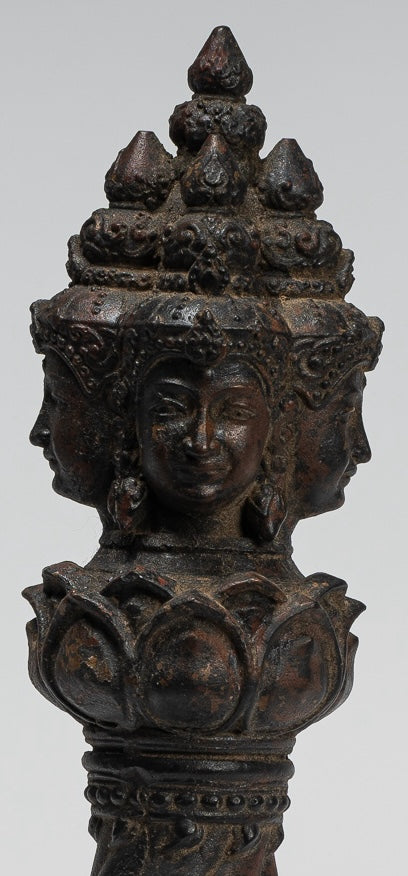
Ayudhapurusha: The Divine Personification of Weapons in Hinduism
Hinduism, with its rich tapestry of mythology and symbolism, attributes divine significance to even the weapons wielded by gods and goddesses. One such fascinating concept is Ayudhapurusha, the personification of divine weapons.
In Hindu tradition, weapons are not merely inanimate objects; they are living embodiments of divine energy and cosmic principles, each possessing distinct characteristics, stories, and roles in the cosmic order.
What is Ayudhapurusha?
Ayudhapurusha (from Sanskrit: Ayudha meaning ‘weapon’ and Purusha meaning ‘person’) refers to the anthropomorphic manifestation of divine weapons. These entities are often depicted in Hindu scriptures as possessing consciousness, taking physical form to interact with the gods and serve a greater dharmic purpose. In many cases, they also act independently, offering guidance and divine intervention during cosmic battles.
Significance of Ayudhapurusha in Hindu Mythology
The concept of Ayudhapurusha underscores the belief that weapons wielded by deities are not mere tools but manifestations of their cosmic power. They are considered divine beings who play a vital role in maintaining balance between good and evil. Their depictions in scriptures reinforce the idea that divine power does not exist solely in forms of deities but also extends to the instruments they use to execute their will.
Prominent Ayudhapurushas and Their Stories
1. Sudarshana Chakra - The Discus of Lord Vishnu
One of the most well-known Ayudhapurushas is Sudarshana Chakra, the celestial discus wielded by Lord Vishnu. It is personified as a divine being who serves Vishnu in his battles against evil forces. Sudarshana Chakra is described as having the power to annihilate adharma (unrighteousness) instantly. He is sometimes depicted as a fierce deity with multiple arms, each holding weapons of immense power.
In the Vishnu Purana, Sudarshana is revered as a deity in his own right, worshipped by devotees seeking protection and righteousness.
2. Nandaka - The Sword of Lord Vishnu
Nandaka is the divine sword of Vishnu, often depicted as a radiant weapon symbolizing knowledge and the destruction of ignorance. Nandaka is believed to have taken a humanoid form in some scriptures, serving Vishnu in battles against demonic forces.
3. Pinaka - The Bow of Lord Shiva
Pinaka, the great bow of Lord Shiva, is another Ayudhapurusha of immense significance. This weapon, known for its invincible power, was used by Shiva to destroy the demon Tripurasura. The bow is also mentioned in the Ramayana, where Lord Rama breaks it during Sita’s swayamvara (marriage contest), proving his divine strength.
4. Sharanga - The Bow of Lord Vishnu
Sharanga is Vishnu’s celestial bow, often regarded as an indestructible weapon. It is sometimes described as taking a divine form and playing a crucial role in battles between the gods and asuras (demons).
5. Trishula - The Trident of Lord Shiva
Trishula, the three-pronged trident of Shiva, represents the destruction of evil, ignorance, and ego. While primarily seen as a weapon, Trishula is also revered as a divine being that symbolizes the three fundamental aspects of existence: creation, preservation, and destruction.
6. Vajra - The Thunderbolt of Lord Indra
The Vajra, wielded by Indra, the king of gods, is another prominent Ayudhapurusha. Forged from the bones of the sage Dadhichi, Vajra personifies immense power and righteousness. It serves as Indra’s primary weapon against demonic forces and is often described as having its own consciousness and role in upholding dharma.
7. Kaumodaki - The Mace of Lord Vishnu
Kaumodaki, the divine mace of Vishnu, symbolizes supreme strength and authority. Like other divine weapons, it is sometimes personified as an entity that plays an active role in cosmic battles, crushing forces of adharma.
Ayudhapurusha in Worship and Rituals
Many temples across India dedicate special rituals to divine weapons, treating them as sacred deities. The Sudarshana Chakra, in particular, is widely worshipped in Vishnu temples, and there are specific Chakra Pujas performed for protection and spiritual upliftment. Similarly, the Trishula is a revered object in Shiva temples, symbolizing his supreme authority over the universe.
Symbolism and Philosophical Interpretation
The concept of Ayudhapurusha carries deep philosophical significance in Hinduism. Each weapon represents a particular cosmic force and its divine embodiment signifies the active role of dharma in maintaining balance in the universe. These weapons are not merely instruments of war but symbolize divine will, knowledge, strength, and justice.
For instance:
-
The Sudarshana Chakra represents time and righteousness.
-
The Trishula symbolizes the threefold nature of existence.
-
The Vajra stands for unyielding spiritual power and determination.
Conclusion
Ayudhapurusha is a unique and profound aspect of Hindu mythology, reflecting the divine consciousness attributed to sacred weapons. These personifications emphasize that power, when wielded for dharma, is not destructive but transformative.
Whether in scriptures, rituals, or temple iconography, Ayudhapurushas continue to inspire devotion and reverence, reminding us of the eternal battle between good and evil and the divine forces that safeguard righteousness.
The next time you see a depiction of a deity wielding a powerful weapon, remember—the weapon itself may be an Ayudhapurusha, a conscious force playing a pivotal role in the cosmic order.






















